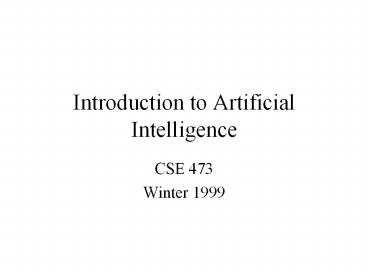Introduction to Artificial Intelligence - PowerPoint PPT Presentation
Title:
Introduction to Artificial Intelligence
Description:
Introduction to Artificial Intelligence CSE 473 ... An Intelligent Agent Outline of the Course Search: the fundamental tool of AI programs. Lisp briefing. – PowerPoint PPT presentation
Number of Views:425
Avg rating:3.0/5.0
Title: Introduction to Artificial Intelligence
1
Introduction to Artificial Intelligence
- CSE 473
- Winter 1999
2
Logistics
- Instructor Alon Levy (alon_at_cs) Sieg 310.
- Office hours Monday, 330-430pm.
- Email is good, but expect delays.
- TA Steve Wolfman (wolf_at_cs) Sieg 428
- www.cs.washington.edu/education/courses/cse473/99w
i - (not really there yet).
- Mailing list cse473_at_cs.
- Subscribe by sending mail to majordomo_at_cs.
- (not there yet either).
3
Reading
- Required text
- Artificial Intelligence Theory and Practice
- Dean, Allen, Aloimonos
- Addison Wesley
- Other good books
- Russell Norvig Artificial Intelligence - a
Modern Approach. - Genesereth Nilsson Logical Foundations of
Artificial Intelligence.
4
Grading
- Problem sets mostly programming assignments
(Lisp more on this soon). - Midterm
- Final
- Class participation and discussion.
5
What is Artificial Intelligence?
6
Some Definitions (I)
The exciting new effort to make computers think
machines with minds, in the full literal sense.
Haugeland, 1985
(excited but not really useful)
7
Some Definitions (II)
The study of mental faculties through the use of
computational models.
Charniak and McDermott, 1985
A field of study that seeks to explain and
emulate intelligent behavior in terms of
computational processes.
Schalkoff, 1990
(Applied psychology philosophy?)
8
Some Definitions (III)
- The study of how to make computers do things
at which, at the moment, people are better.
Rich Knight, 1991
(I can almost understand this one).
9
Dimensions in AI Definitions
- Build intelligent artifacts vs. understanding
human behavior. - Does it matter how I built it as long as it does
the job well? - Should the system behave like a human or behave
intelligently?
The Turing Test
10
What Does AI Really Do?
- Knowledge Representation (how does a program
represent its domain of discourse?) - Automated reasoning.
- Planning (get the robot to find the bananas in
the other room). - Machine Learning (adapt to new circumstances).
- Natural language understanding.
- Machine vision, speech recognition, finding data
on the web, robotics, and much more.
11
A Brief History of AI
- The Dartmouth conference, Summer 56.
- Early enthusiasm 52-59
- Puzzle solving with the General Problem Solver,
Geometry theorem prover, Checkers player, Lisp. - Reality strikes
- Programs dont scale up.
- The problem is not as easy as we thought
- The spirit is willing but the flesh is weak --gt
- The vodka is good but the meat is rotten.
12
More History
- Knowledge-based systems (expert systems)
1969-1979 - Ed Feigenbaum (Stanford) Knowledge is power! (as
opposed to weak methods) - Dendral (inferring molecular structure from a
mass spectrometer). - MYCIN diagnosis of blood infections
- AI becomes an industry
- R1 configuring computers for DEC.
- Robotic vision applications
13
Recent Events 1987-Present
- AI turns more scientific, relies on more
mathematically sophisticated tools - Hidden Markov models (for speech recognition)
- Belief networks (see Office 97).
- Focus turns to building useful artifacts as
opposed to solving the grand AI problem. - The victory of the neats over the scruffies?
14
Recent AI Successes
- Deep Blue beats Kasparov (AI?)
- Theorem provers proved an unknown theorem.
- Expert systems medical, diagnosis, design
- Speech recognition applications (in limited
domains). - Robots controlling quality in factories.
- Intelligent agents on board Deep Space 1.
15
An Intelligent Agent
Natural lang. vision
effectors
input
learning
Knowledge representation
reasoning
planning
16
Outline of the Course
- Search the fundamental tool of AI programs.
- Lisp briefing.
- Knowledge representation
- propositional logic
- first-order logic
- inference (soundness and completeness)
- specialized formalisms Horn rules, description
logic. - Non-monotonic reasoning
- Reasoning with uncertainty
- Planning
- Machine learning
- Natural language understanding
- More, as time allows.































